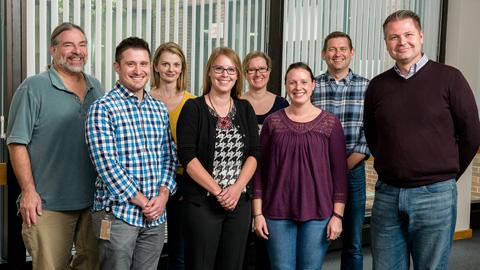In the past, nonhuman primate research has relied on only a few infectious molecular clones for numerous diverse research projects including pathogenesis, preclinical vaccine evaluations, transmissions, and host vs. pathogen interactions.
But new data suggests that there is a selected phenotype of the simian immunodeficiency virus (SIV) that causes infection. A team led by Brandon Keele, Ph.D., senior principal scientist, Retroviral Evolution Section, AIDS and Cancer Virus Program, set out to generate and characterize infectious molecular clones from two widely used SIV lineages (SIVmac251 and SIVsmE660) representing viruses that initiate infection in rhesus macaques.
Although a transmitted virus’ exact requirements aren’t yet fully understood, the team was able to generate cloned viruses with all the functional characteristics of a transmitted/founder virus—that is, clones that contain the exact nucleotide sequence of the virus that established a new infection in a naïve host.
The cloned viruses revealed typical acute and set point viral load dynamics with pathological immune activation, lymphoid tissue damage progressing to significant immunodeficiency, and AIDS-defining clinical endpoints in some animals.
These clones represent a new molecular platform for studies that require authentic transmitted/founder viruses. It’s possible this research will allow scientists to determine the characteristics necessary to establish a new infection, which would then allow them to look for ways and mechanisms to prevent infection.
“Understanding what is needed for a virus to cross a mucosal surface and initiate a new infection (while the new host is trying to kill it) is important for scientists trying to develop strategies to block infections,” said Keele. Ultimately, this line of research could help advance the HIV/AIDS vaccine agenda by providing challenge models that authentically recapitulate HIV transmission in humans.
Keele received his Ph.D. at Brigham Young University. As a graduate student, he became fascinated with viral evolution, especially how a virus evolves to evade immune responses, allowing it to persist for a lifetime. He decided to specialize in HIV research so he could help those infected with this deadly virus.
He then did a postdoctoral fellowship at the University of Alabama at Birmingham, where he used viral evolution to identify the geographic origins of HIV from chimpanzees. He has also used similar approaches to discover that the vast majority of new HIV infections can be traced back to a single founder virus. After working at the University of Alabama at Birmingham, he came to the Frederick National Laboratory for Cancer Research, where he has now worked for 7.5 years.
Keele’s lab is currently studying three things:
- The dynamics of viral transmission—how the virus crosses the mucosal barrier, where it replicates during primary infection, and how it spreads to the systemic compartment.
- Viral escape from cellular immunity—what is the timing of escape, the different mutations generated, and the number of viral genomes participating in the escape.
- Cure research—how long-lived viral reservoirs contribute to rebound viremia, how many genomes rebound at one time, and whether this can be used to measure the size of the latent reservoir.


